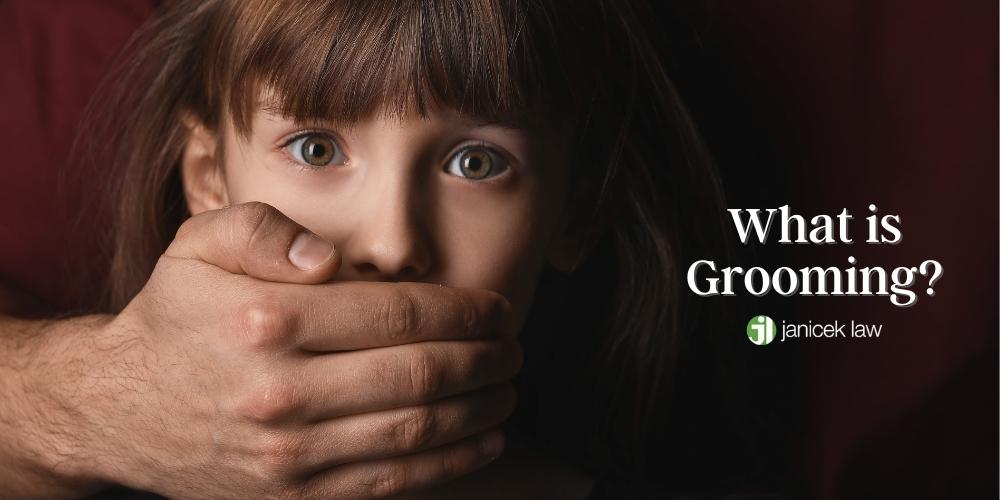Child grooming is a direct precursor to child sexual abuse. Grooming occurs when a sexual predator develops a close, trusting relationship with the child – and even their parents – so that they can eventually engage in sexual activity with the child. The goal is to develop trust and an emotional bond so that both the parent’s and child’s inhibitions are lowered. That way, they can easily desensitize the child to various forms of sexual contact and sexual exploitation. Tragically, many child abuse cases begin this way. Understanding sexual grooming is crucial for protecting our children. Below, San Antonio sexual abuse lawyers at Janicek Law break down the dangers and signs of grooming so that our society can better protect children from sexual trauma.
If you or someone you love has been sexually exploited or abused, you have grounds to file a civil lawsuit in the state of Texas. San Antonio sexual abuse lawyers at Janicek Law have the skills and experience necessary to obtain financial compensation for those who have suffered abuse from clergy members, teachers, doctors, therapists, Boy scout leaders, and more. Call 210-366-4949 to schedule a free consultation with our legal team today.
What is Grooming?
Grooming occurs when a sexual predator intentionally develops an emotional connection with a child or young person with the intent of later engaging in sexual activity. Sexual predators often develop a close relationship with the child’s family as well, so that everyone’s inhibitions are lowered when the predator begins sexually abusing the child.
Child molesters also use grooming tactics to lure young children and teens into other sexual exploitation offenses like child pornography, trafficking, prostitution, and more.
Sexual predators tend to be very skilled at psychological manipulation, which is a crucial component of grooming children and their families. Predators will appear normal, kind, helpful, and trustworthy. But later on, they may use lies, threats, violence, or other coercive tactics to begin a sexual relationship with a child.
Where Can Grooming Happen?
Grooming can happen almost anywhere, but the following situations are most common:
- Online through social networking sites
- In person
- Schools
- The workplace
- Church
- Summer camps
- During Boy Scouts activities
Most of the time, sexual predators are not strangers. In fact, 93% of child sexual abuse victims knew their abuser according to the Rape, Abuse & Incest National Network (RAINN).
Ever since smartphones and computers have become an integral part of our lives, online child grooming has become incredibly common. In fact, online grooming is most common among victims between the ages of 13 and 17 (99% of grooming cases). Meanwhile, 48% of online grooming cases occur within the ages of 13 to 14. Most of these victims are young girls.
Children are very naive and naturally trusting in almost any situation. But this naivety and trust is even more dangerous in a virtual setting because the child may think they’re talking to someone else their age, when really they’re talking to a middle-aged man. The predator may gain enough of the child’s trust to schedule an in-person meeting, which is usually when the sexual abuse occurs.
What Are the Stages of Grooming?
Child groomers follow a specific formula in order to eventually engage in sexual contact with the child. Listed below are the main stages of the grooming process:
- Select the Victim: First, the predator will choose their victim by watching them for a period of weeks or months. A predator may choose a victim based on how easy it is to see them or talk to them, how naive they are, or how often their parents are around.
- Gain Access to the Victim: Then the predator will gain access to the victim through some kind of casual encounter. They will seem kind, warm, welcoming, and trustworthy so that the child (and/or their parents) will lower their guard around them.
- Gain Trust: Next, the predator will make it their top priority to gain the victim’s trust. Many times, this means gaining the trust of the child’s parents as well. They may do this by giving the child gifts, constantly praising the child, and spending lots of time with the child.
- Isolate the Child: Once the predator develops a close relationship with the child, they will slowly begin to isolate them from their family and friends. Predators isolate children so that they will feel like this person is their best friend, and they can trust and go to them for anything.
- Normalize Sexual Contact: Next, the predator will slowly introduce physical touch and sexual activities to the child. It may begin with hugging, tickling, wrestling, and even hand holding. Then the predator may show the child sexual material, such as porn or sexual photos. Once the child is fairly desensitized to all these things, the predator may move on to sexual intercourse, molestation, and more.
- Maintain Power and Control: By the last stage of grooming, the loving relationship that the child once felt with the predator is largely gone. That’s because the predator’s main goal is to keep control and power over the child for as long as possible. They may resort to lies, threats, and even violence to keep engaging in sexual activity with the child.

How a Sexual Predator Targets Children
When most parents hear of child grooming, they immediately resort to shaming the parents for ever allowing the predator to become so close to the child to begin with. But what they don’t understand is that the predator starts off with very innocent tactics to target children. They may start with the common behaviors listed below, and then slowly move up to sexual exploitation.
- The predator will be on the lookout for a child of their preferred age and gender.
- The predator first takes a special interest in the child and/or their family.
- As they get to know the child and their family better, they will look for opportunities for alone time.
- The predator becomes increasingly involved in the child’s life. They may volunteer at school or church functions, they may offer to take the child to their sports games or music lessons, and they may even offer to tutor a school subject that they’re struggling in.
- The predator is also very friendly and involved with the family, but during family functions and activities, the predator will take special interest in emotionally bonding with the child.
- The predator may frequently buy the child toys and treats.
- Lastly, the predator will stay in contact with the whole family, but with the sole purpose of maintaining access and control over the child.
What are the Signs of Sexual Grooming in Children?
Warning signs of child grooming are as follows:
- Walking in on a child while they’re changing clothes, using the bathroom, or showering, but framing it as an accident, especially to the parents.
- Asking a child to come to the bathroom with them.
- Offering to help a child bathe or change their clothes.
- Planning or engaging in activities that require very little clothing, such as swimming.
- Frequent “innocent” touch between the child and the predator, such as hugging, hand holding, tickling, putting a hand on their lower back while they walk by, etc.
- Playing, tickling, or wrestling with very little clothing on.
- Showing sexual images or porn to the child.
- Telling sexual jokes to the child.
- Teaching the child about sexual topics and framing it as pure education.
- Taking pictures of the child in their bathing suit or when the child has very little clothing on in general.
Sexual Grooming for Adults
Grooming doesn’t just happen to children, although most cases of sexual grooming do involve children or young people. Vulnerable adults – such as those between the ages of 18 and 25 – can be victims of sexual grooming as well.
The predator will follow a similar grooming formula as they would with a child. The main difference is that the predator will have to gain consent from the adult to begin a romantic relationship. But they will engage in the relationship with the goal of sexual exploitation.
They may begin by forming a harmless friendship with the adult. Then, they will likely use flattery, gifts, promises, and romantic gestures to begin a romantic relationship. Many times, the predator will lie about their name, their job, and almost every aspect of their lives, so the adult victim doesn’t really know who they are. They do all this to follow the same grooming formula: gaining access, gaining trust, isolating, and finally, maintaining control.
The Connection Between Grooming and Human Trafficking
Human trafficking is modern day slavery. The crime is characterized by using lies, force, and/or coercion in order to get the victim involved in forced labor or commercial sexual exploitation. Both children and adults can be victims of human trafficking.
Human trafficking can include:
- Sex trafficking, which is when victims are transported nationally or internationally for the sake of sexual exploitation.
- Debt bondage, which is when a victim’s body is used to pay off debt.
- Forced labor or involuntary servitude, which is when victims are forced to do some kind of labor without consent.
Signs That Someone is Being Groomed for Human Trafficking
Grooming happens very gradually, so sometimes it’s hard to catch. Be on the lookout for the following signs that someone is being groomed for human trafficking:
- They start talking about new, expensive gifts and cash from a potential romantic partner.
- Their general attitude and behavior changes since meeting a new friend or romantic partner.
- They suddenly detach themselves from old friend groups and instead hang out with new friends associated with the romantic partner.
- They stop participating in their normal hobbies and activities.

Call San Antonio Sexual Abuse Lawyers at Janicek Law Today
If you or a loved one has been sexually abused by a clergy member, teacher, doctor, therapist, Boy Scout leader, or camp counselor, you have grounds to take legal action. San Antonio sexual abuse lawyers at Janicek Law are passionate about pursuing justice and financial compensation for those who have suffered extensive sexual and emotional trauma. We understand that filing a lawsuit can’t undo the damage, but it can give you a sense of closure so that you can finally heal. Call 210-366-4949 to schedule a free consultation with our legal team today.

